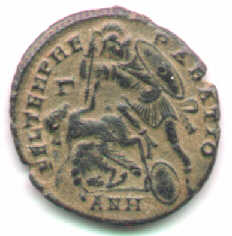When was the stirrup introduced to western civilization?
There is a dispute about this. Thoughts range from the sixth or even seventh century to much
earlier, but there is little evidence. This coin provides some primary evidence, open to
interpretation. It was certainly minted between 348 and 355 AD and may or
may not depict a stirrup in use.
 The obverse depicts the emperor
Constantius II (337-361). The reverse is
the interesting part. The type is the very common "soldier spearing falling horseman" type in
which a giant (Roman) foot soldier thrusts a spear downward into a tiny barbarian (Persian?
Goth?) horseman whose horse is about to tumble forward over its head. The horseman twists
back, looks up, and raises his hand to ward off the spear. Of interest is the line down the
horseman's left leg and the loop around his foot that looks like a stirrup. Is it really intended
to represent a stirrup? If it is, the stirrup was known to some Roman coin engraver c. 350 AD.
Or, is it just the leading edge of the barbarian's trousers and a curve outlining the foot?
Remember, the scale of this is small - the entire leg from knee to foot is only about 5mm long.
The obverse depicts the emperor
Constantius II (337-361). The reverse is
the interesting part. The type is the very common "soldier spearing falling horseman" type in
which a giant (Roman) foot soldier thrusts a spear downward into a tiny barbarian (Persian?
Goth?) horseman whose horse is about to tumble forward over its head. The horseman twists
back, looks up, and raises his hand to ward off the spear. Of interest is the line down the
horseman's left leg and the loop around his foot that looks like a stirrup. Is it really intended
to represent a stirrup? If it is, the stirrup was known to some Roman coin engraver c. 350 AD.
Or, is it just the leading edge of the barbarian's trousers and a curve outlining the foot?
Remember, the scale of this is small - the entire leg from knee to foot is only about 5mm long.
There are many extant examples of this coin type. It seems the barbarian is wearing loose or fringed or baggy trousers that are
depicted by four or five diagonal strokes sloping down the leg from front to back, so the trailing
edge of the trousers is not a line. But the leading edge is a firm line and there is a loop around the
foot. Other examples also show this clearly. It looks a lot like a stirrup, doesn't it?
Page 1 of Ancient Roman and Greek Coins
Return to page 2 of Ancient Roman and Greek
Coins
 The obverse depicts the emperor
Constantius II (337-361). The reverse is
the interesting part. The type is the very common "soldier spearing falling horseman" type in
which a giant (Roman) foot soldier thrusts a spear downward into a tiny barbarian (Persian?
Goth?) horseman whose horse is about to tumble forward over its head. The horseman twists
back, looks up, and raises his hand to ward off the spear. Of interest is the line down the
horseman's left leg and the loop around his foot that looks like a stirrup. Is it really intended
to represent a stirrup? If it is, the stirrup was known to some Roman coin engraver c. 350 AD.
Or, is it just the leading edge of the barbarian's trousers and a curve outlining the foot?
Remember, the scale of this is small - the entire leg from knee to foot is only about 5mm long.
The obverse depicts the emperor
Constantius II (337-361). The reverse is
the interesting part. The type is the very common "soldier spearing falling horseman" type in
which a giant (Roman) foot soldier thrusts a spear downward into a tiny barbarian (Persian?
Goth?) horseman whose horse is about to tumble forward over its head. The horseman twists
back, looks up, and raises his hand to ward off the spear. Of interest is the line down the
horseman's left leg and the loop around his foot that looks like a stirrup. Is it really intended
to represent a stirrup? If it is, the stirrup was known to some Roman coin engraver c. 350 AD.
Or, is it just the leading edge of the barbarian's trousers and a curve outlining the foot?
Remember, the scale of this is small - the entire leg from knee to foot is only about 5mm long.